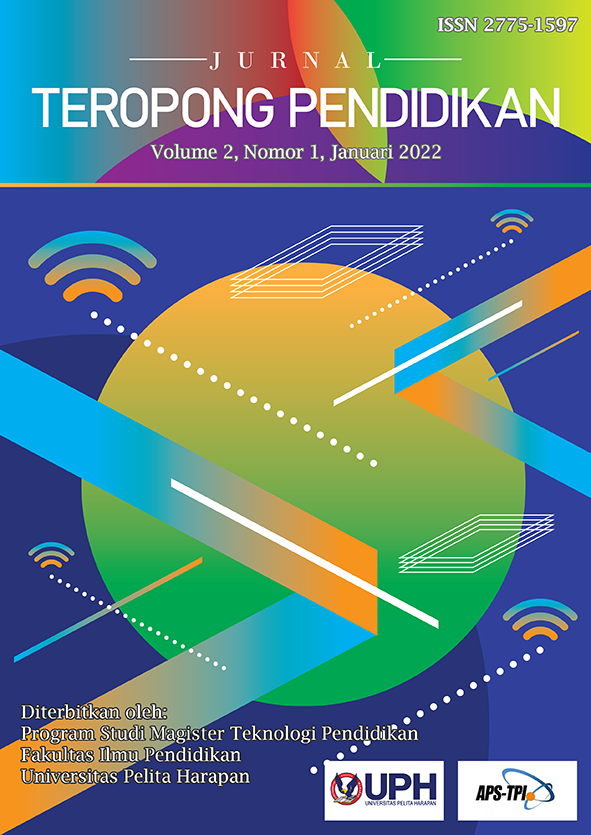Mengembangkan Keterampilan Memahami Cerita, Menulis, dan Kosakata Bahasa Inggris Anak TK B melalui Kegiatan Membacakan Buku Cerita [Developing Comprehension, Writing, and Vocabulary Skill of Kindergarten 3 Students Through Story Reading Activity]
DOI:
https://doi.org/10.19166/jtp.v2i1.5068Trefwoorden:
Comprehension skill, writing skill, vocabulary skill, story readingSamenvatting
Literacy skill is essential for students’ academic success. Yet, language learning at schools takes less attention in comprehension skill and vocabulary that are integral parts of reading and writing as it focuses more on reading words. This research investigated the implication of story reading activities on the development of Kindergarten 3 students’ comprehension, writing, and vocabulary skill. It particularly aimed to: (1) describe students’ comprehension, writing, and vocabulary skill before the implementation; (2) describe the implementation of story reading activity; (3) analyze the development of students’ comprehension, writing, and vocabulary; (4) identify the obstacles during the implementation process. The classroom action research conducted in this study was carried out in three cycles. The research subjects were 20 students. Data were collected by using observation, field notes, interview, and written test, then analyzed with descriptive qualitative. The results showed: (1) the students still needed time to develop the three target skills; (2) the implementation used reading strategies consistently; (3) there is significant improvement with N-gain of 0.8 for comprehension skill, 0.63 for writing skill, and 0.8 for vocabulary knowledge; (4) suitable test formation made to ease students in doing the test, personal approach was applied to deal with certain students’ characteristic, and adjustment to learning schedule was made in conducting this research.
Referenties
Arikunto, S. (2013). Prosedur penelitian: Suatu pendekatan praktik. Rineka Cipta.
Farrel, T. S. C. (2002). Planning lessons for a reading class. SEAMEO Regional Language Centre.
Gibbons, P. (2002). Scaffolding language scaffolding learning teaching second language learners in the mainstream classroom. Heinemann.
Hake, R. R. (1999). Analysing change gain score. https://web.physics.indiana.edu/sdi/AnalyzingChange-Gain.pdf
Hoff, E. (2005). Language development (3rd ed.). Thomson Learning.
Kennedy, E., Dunphy, E., Dwyer, B., Hayes, G., McPhillips, T., Marsh, J., O'Connor, M., & Shiel, G. (2012). Literacy in early childhood and primary education (3-8 years). National Council for Curriculum and Assessment.
Neuman, S. B., Copple, C., & Bredekamp, S. (2000). Learning to read and write developmentally appropriate practices for young children. National Assosiation for the Education of Young Children.
Parlakian, R. (2004). Early literacy and very young children. Zero to Three, 25(1), 37-44.
Pikulski, J., & Templeton, S. (2004). Teaching and developing vocabulary: Key to long-term reading success. Houghton Mifflin Company.
Reilly, J., & Reilly, V. (2005). Writing with children. Oxford University Press.
Snow, C. E., Burns, M. S., & Griffin, P. (eds.) (1998). Preventing reading difficulties in young children. National Academy Press
Wardhani, I. G. A. K., & Wihardit, K. (1997). Penelitian tindakan kelas. Universitas Terbuka.
Winch, G., Johnston, R. R., March, P., Ljungdahl, L., & Holliday, M. (2006). Literacy: Reading, writing and children's literature. Oxford University Press.
##submission.downloads##
Gepubliceerd
Nummer
Sectie
Licentie
Authors who publish with this journal agree to the following terms:
1) Authors retain copyright and grant the journal right of first publication with the work simultaneously licensed under a Creative Commons Attribution License (CC-BY-SA 4.0) that allows others to share the work with an acknowledgement of the work's authorship and initial publication in this journal.
2) Authors are able to enter into separate, additional contractual arrangements for the non-exclusive distribution of the journal's published version of the work (e.g., post it to an institutional repository or publish it in a book), with an acknowledgement of its initial publication in this journal.
3) Authors are permitted and encouraged to post their work online (e.g., in institutional repositories or on their website). The final published PDF should be used and bibliographic details that credit the publication in this journal should be included.





